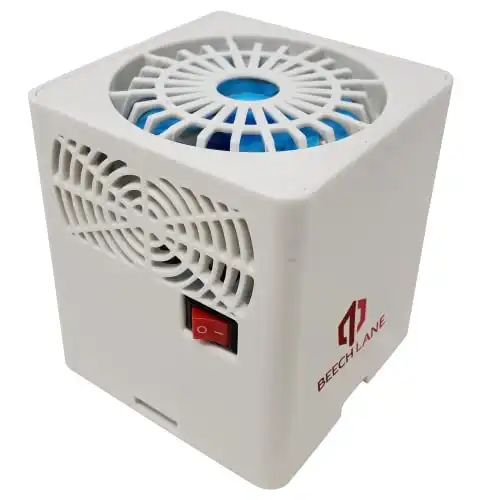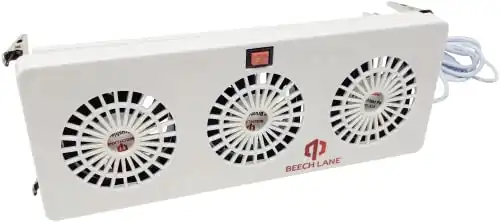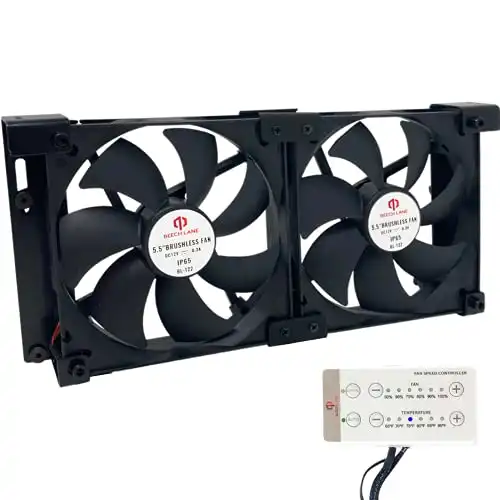The RV refrigerators have been around for a long time. In the 1950s, the refrigerator became a standard appliance in RVs and has stayed that way ever since. Aside from some regular upgrades in features, size, and weight, the technology behind RV refrigerators hadn’t changed too much until recently, when residential model refrigerators started entering the mobile market. Most RV refrigerators use a combination of gases and chemical reactions to evaporate and condense the air inside the refrigerator, making it cool. This process is called absorption; hence the name absorption refrigerator found in just many RVs on the road—refrigerators in your home and some new RVs use a compressor to keep the air cool.

All absorption fridges heat the gases and liquids that travel through the inside refrigerator casing and create evaporation, pulling heat away from the inside and leaving cool air behind. This process continues while your refrigerator runs with an electric heating element or a propane flame and gradually cools it down. It’s pretty remarkable to think how heat and be used to cool.

Most RVs will have a dual system, using both electric and propane, depending on whether you’re connected to shore power. In either case, you need a power source to allow it to run. For example, a refrigerator running off propane will need power from the 12V battery to work. However, the electricity needed with propane is minimal, allowing you to run it for a long time without being connected to the electric grid.
How long does it take to cool an RV refrigerator?
One thing you likely noticed with your RV fridge is that it cools much more gradually than a traditional residential fridge. This reason is because the absorption process takes more time than a compressor. You probably, at one point or another, questioned if your refrigerator was actually working when plugged in, probably because of the slow cooling time and the ultra-quiet operation.
It can take up to 24 hours of run time to reach peak cooling temperatures. While it will feel cooler and cooler while it runs through the absorption process, the first few hours may seem painstakingly slow. Therefore, starting your RV refrigerator as soon as possible is always a good idea to have a nice cold place to put your food. In addition, many campers will start their RV refrigerator before heading out on the road, allowing it to cool while you travel (yes, this is completely safe).
Uneven cooling
One of the downsides of an EV refrigerator that many RVers experience is uneven cooling. Since there are no moving parts in the RV refrigerator, which has its advantages, it also means that there is typically no way to circulate the air. So instead, the refrigerator creates some cooling points, which cools the fridge like a big ice box.
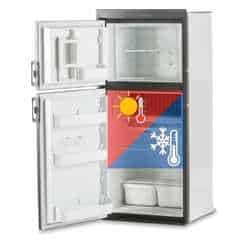
When the refrigerator is empty, the cooler air moves throughout the open area, creating a more even cooling. However, once you load up the refrigerator, your stored items can block some of the air from moving around, creating cold and warm spots. Have you ever found the need to move things around because some items are not getting as cold as they should while others may start to freeze?
One of the best solutions we’ll discuss below is to install a small air circulation fan in the refrigerator. This upgrade will help to keep the cooler air flowing throughout the entire fridge.
Setting the Temperature:
Before we jump into air circulation, you’ll need to understand the thermostat. While air circulation can be a problem, an improperly set thermostat is another common issue facing many RVers.
If you open your refrigerator and realize it has turned into a large freezer, chances are that you have the temperature set too cold. Unless you have a dial temperature control gauge, you likely have a manual adjustment, consisting of a sleeve attached to one of the cooling fins (see image below). The temperature control works by sliding the sleeve up or down on the fin. If you slide it up, you are increasing the coldness of the refrigerator. If you slide it down, the opposite is true, making the refrigerator warmer. Inside the sleeve is a small sensor that reads the temperature of the metal plate and will regulate the refrigerator by turning it off and on.

The absorption process will start if the sensor signals that it needs to get colder. However, if the sensor constantly sends that signal, even though it’s adequately cool, the absorption process will keep running, and the cooling unit will freeze items in your refrigerator.
The first step to troubleshooting an improperly cooling refrigerator is to adjust the sleeve to increase or decrease the temperature. It can take time for the refrigerator to adjust to the new setting, so give it about a day to see if this solves your problem. If it does not, you may need to replace the sleeve and sensor with a new one. These can easily be found at most RV stores or online at sites like Amazon.
One sign that you need to adjust your RV’s fridge is seeing water drips coming down from your freezer. These drips indicate that your fridge and freezer should be cooler. Another common problem is frost buildup. RV refrigerators are notorious for freezing up. When this happens, your sensor will think that the refrigerator’s temperature is colder than it is and will warm up, and you’ll likely notice ice buildup on the fins.

When your refrigerator is freezing, it is best to thaw it out. To do this, turn off the refrigerator and open the door so the accumulated ice can melt. You can speed this up with a hairdryer and physically remove the ice as it loosens. Using the hairdryer method, you can typically defrost a refrigerator in 10-15 minutes.
The next step is ensuring that all of your seals are good. To test them, you can use the paper method. Insert a folded sheet of paper into the refrigerator and close the door around it. Slowly try to pull it out. You should feel a good amount of resistance. If it slides right out, you may have a weak seal. If you have a bad seal, in addition to letting cold air escape, it will let warm moist air into the refrigerator. This moisture is what causes the ice buildup. You can purchase new seals online and replace them. Finally, check all of your seals around both your refrigerator and freezer.
Improving RV Refrigerator Air Circulation
Assuming your thermostat is working properly but you’re dealing with uneven cooling, a simple and cost-effective solution is to install an air circulation fan. Again, this problem is a super easy fix with almost immediate results.

The technology behind the fan is pretty basic- it moves air. However, you have several options to install one. A second option is to install an RV refrigerator vent fan. This type of fan is installed in the dead space behind the exterior vent cover, and in warm weather, when it senses high temperatures, it kicks on and exhausts the warmer air away from the refrigerator coil area. Below, we’ll review two fantastic products that will solve all of your uneven refrigerator cooling woes.
Our pick for the best RV refrigerator fans: Beech Land RV Refrigerator Fans
Outdoor Miles received a couple of RV refrigerator fans to test out, so we immediately shipped them out to one of our RV gear testers, Tana, to put them through their paces. We wanted to take some time and put it to work and see how well it helped with improving air circulation in an RV refrigerator. Well, the tests came back and were overweeningly positive.
Tana tested out two fans- a simply battery-powered fan that you place inside the refrigerator and Beech Lane’s newer 12V fan, which attaches to the vent on the backside of the refrigerator. It can also be easily configured to push air through the roof vent for refrigerators with a roof-mounted exhaust. Let’s take a look at the results.
Beech Lane RV Fridge Fan
This little battery-powered fan packs a big punch with a high-power 3,000 R/M motor, which pulls in the cooler air in the refrigerator and recirculates it throughout the interior. The fan is fairly simple in design, using just 2 D size batteries and an easy-to-access on/off switch. You simply install the batteries in the unit, place the fan inside your fridge, and turn it on.
Since warm air rises, the best place to locate the fan is on a lower shelf in the refrigerator, so it pushes the cooler air around. The circulating fan uses a spiderweb top to encourage better airflow when it’s operating. The great thing about the fan is its ability to run for a long time. Before stocking up on D batteries, a single set of fresh batteries will likely last you the entire season since it doesn’t require much power to operate. If left running, a single set of batteries will run the fan for over a month, with some RVers getting up to 2-months of continuous use.

The reason it lasts so long is because of its efficiency. You don’t need much air movement to circulate the cooler air. The small unit packs a big punch and will keep your RV refrigerator temperatures constant throughout your camping trip. It’s a good idea to place the fan in the refrigerator as soon as you start it, which will help it cool quicker and keep the ambient temperature uniform once you start using it. This product is great news for boondockers or folks with solar panel setups. The low draw of the fan won’t impact your battery life much at all. It’s one of the most affordable options for keeping your fridge cooler.
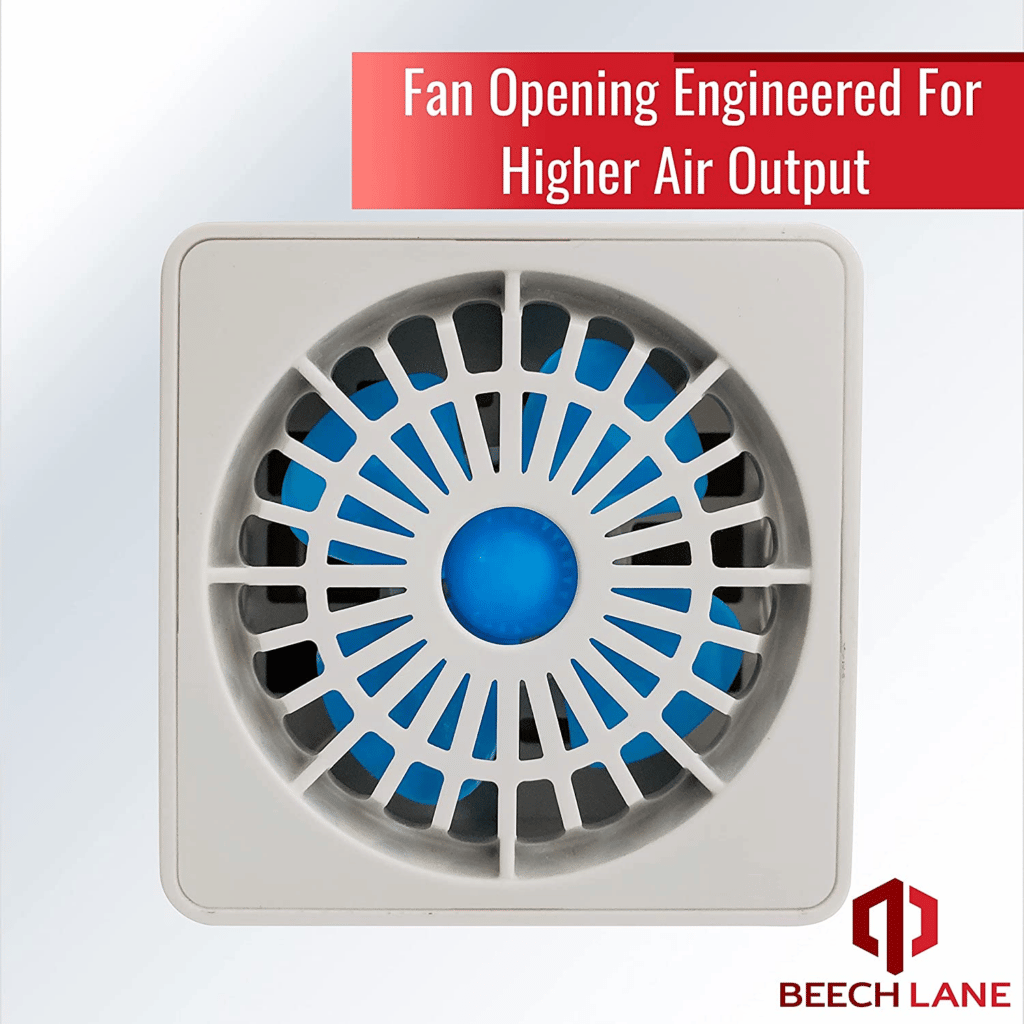
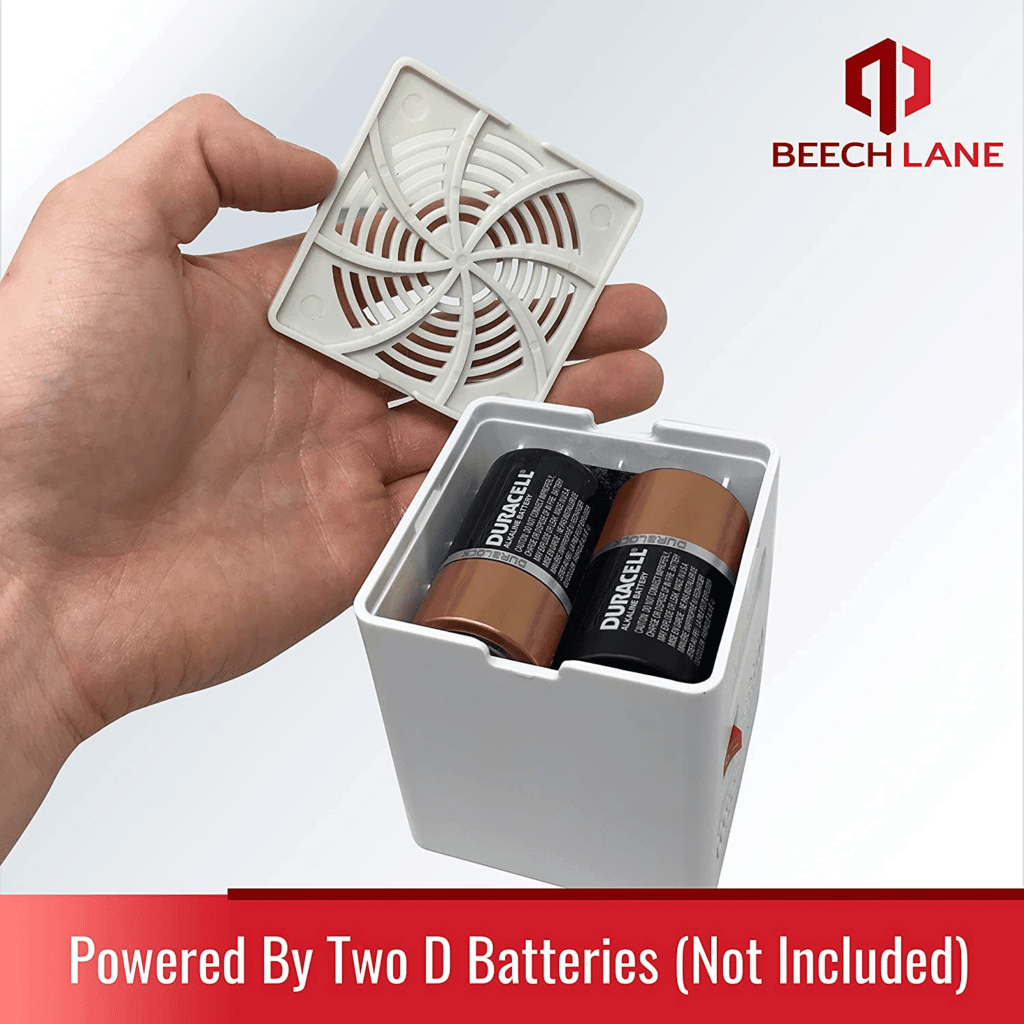

The Beech Lane fridge fan is a great option and simple solution if you need a little help to keep your food cool. It’s a great way to keep your fridge at the optimal temperature, even on hot summer days.
Cons:
A downside to this fan, which also makes it pretty flexible, is that it runs off batteries. Since it lasts a long time, it’s not much of an issue, but it is a good idea to have another set of batteries available when you need to change them.
While not a negative of the fan, another downside is that it will take up (although minimal) some of the limited storage space in a small RV refrigerator. This makes me think- wouldn’t it be smart for refrigerator manufacturers to include a built-in fan?
Let’s find out what Tana had to say about the Been Lane RV Fan:
“This fan is a great little RV gadget! It simply couldn’t be any easier to improve the efficiency of your RV fridge! Just insert batteries, set it in your fridge, turn it on, and you’re all set! But, of course, when you’re camping, you want to focus your time on enjoying being away from home and on the road. But unfortunately, dealing with RV refrigerator cooling issues can be an annoyance at best.
The Beech Lane fan is a simple set-it-and-forget-it solution to this problem. The best thing about it is that it simply works and works well. It helped solve my uneven cooling problems so much that I have seriously considered purchasing one for my home fridge as well! The fridge now has a steady temperature, and since the small interior fan doesn’t make much noise, you don’t even know it’s there where you open the fridge. The Beech Lane fan is a super easy way to keep the inside of the fridge at a consistent temperature.
Before trying this fan, I had problems with temperature fluctuations in different areas of my fridge. For example, to keep items on the middle shelves of my fridge cold, I had to turn the fridge setting up from the 3. I usually run it up to 5 during hot days, and anything up near the fins would freeze. With the addition of this little fan, everything in my fridge stays at a constant temperature without having to change the fridge setting. For best results, keep it on the lower shelf and make sure you don’t block the vents.
As a bonus, the fins on my fridge defrost much better, and I don’t get ‘ice dams’ in the collection tray below the fins. I would call this the best money you could spend on a gadget for your RV to improve your refrigerator’s efficiency and reduce wear and tear simultaneously!”
Beech Lane 12V Refrigerator Evaporator Fin Fan
This past year, Beech Lane brought another innovative fan to the market, this time designing one that connects directly to the fins of your RV refrigerator.
The Beech Lane evaporator fin fan is a cooling device designed to prevent ice buildup and create cold air inside refrigerators. It features three 2.5″ powered fans, providing superior airflow over the evaporator fins compared to competitors with only two fans. The fan is easily attached to the evaporator fins using four alligator clips, ensuring efficient airflow to prevent ice buildup.
The fan can be connected to the 12V power supply inside the fridge or through the back of the fridge, with wire nuts included for installation. Its construction is durable, sleek, and compact, designed to be low-profile and keep wires hidden to avoid damage. An on/off switch allows users to easily control when the fan is in use, saving battery life when not needed.
The product comes with a lifetime manufacturer warranty, ensuring coverage in case of any failure or damage to the evaporator fin fan.
Beech Lane 12V Ventilation Cooling Fan 5.5 inch
One of the biggest headaches with RV refrigerators is their inability to cool efficiently, especially during the summer when temperatures are highest, unlike your residential refrigerator, which sits inside a climate-cooled building. RV refrigerators are often subjected to the outside temperatures, and on hot summer days, they will need to create even more heat to operate.
If you’ve ever camped and noticed that no matter how cold you set your thermostat, the refrigerator just doesn’t want to get cool enough. Having a small child, I usually notice this when trying to freeze ice pops. Unfortunately, it takes forever to get them frozen during the summer, and I’m often left with a handful that is more of a slushy than a frozen treat.
The Beech Land rear vent fan solves this problem by improving the efficiency of your RV refrigerator. It installs easily to the rear vent on the back of the fridge, connects directly to the 12V DC power supply, and uses remote control that provides you complete control over its operation. In extreme heat, this setup will be even more important.
The fan senses the air temperature inside your vent area, and when it gets too high, it exhausts it. The large 5.5-inch fan design will, in turn, improve your refrigerator’s ability to cool, efficiency, and likely extend its life. Keeping the fridge coils in a safe operating temperature environment is an often forgotten method of improving your unit’s cooling ability in hot weather.
Installing the Unit:
The fan is quick and easy to install using the included mounting brackets for American-made RVs. Other fans on the market are designed to work with smaller European refrigerator vents. There is no zip-tying involved, providing a secure and one-time installation. The fan attaches to the inside of the vent, behind the refrigerator.
First, open up the vent cover from the outside. Next, find the best location to mount the fan using the included brackets. It should be positioned to exhaust through the exterior vents. There are three wires coming from the unit. One wire connects to the fans, another to the temperature sensor, and the third to the 12V power supply (your RV’s power source). So you simply tap into the 12V line powering the refrigerator to power the unit. It’s very easy to do. The fan is also very efficient, just using 0.6A of power.
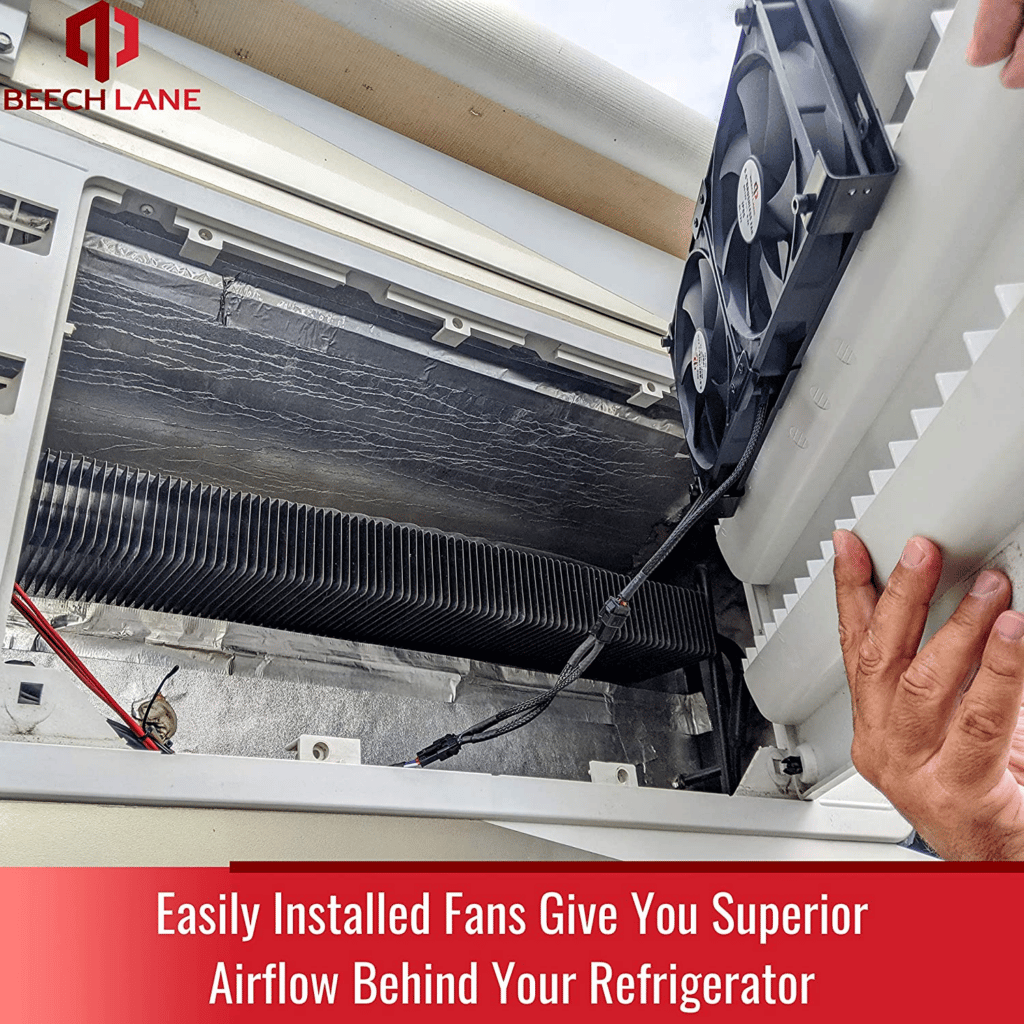
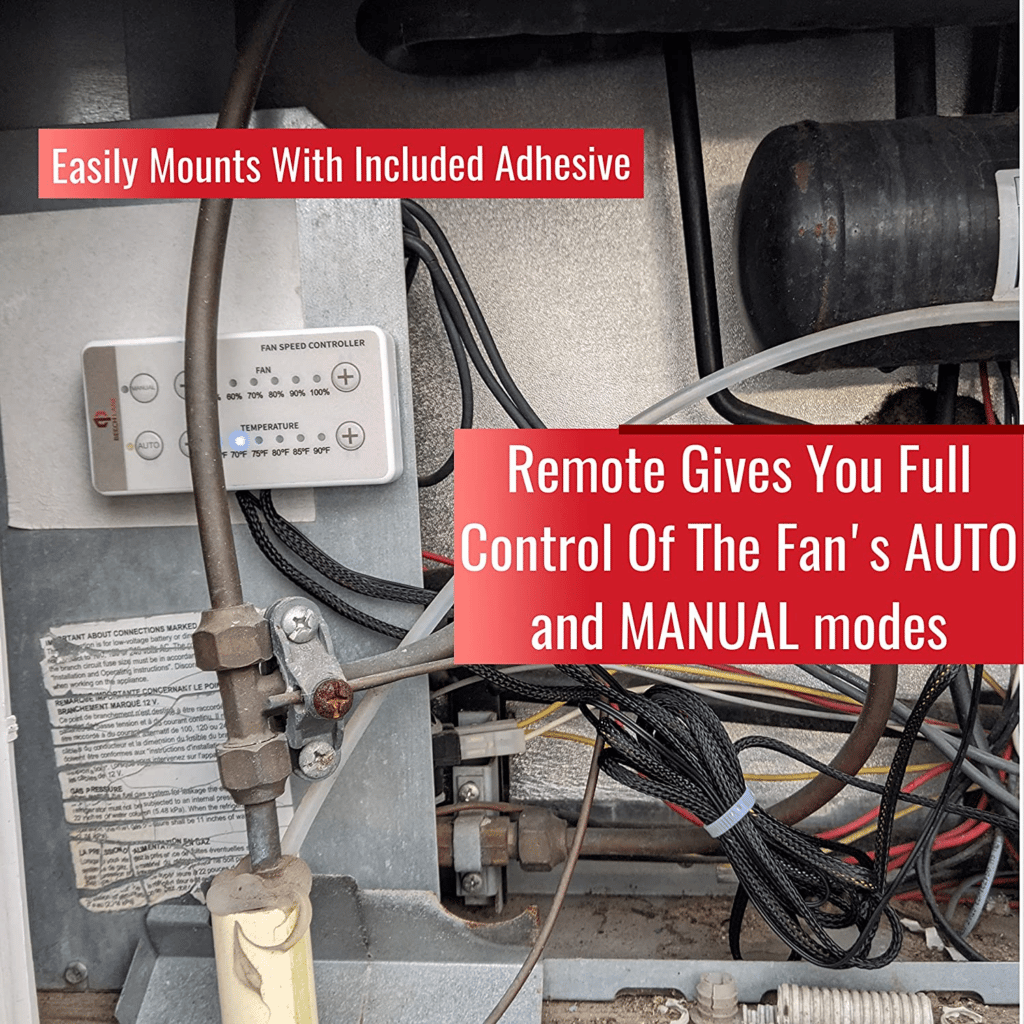
The included control allows you to adjust the fan speed and operation when in use manually. If you don’t want to think about it, set it on auto mode, and the intelligent controller will make all the decisions for you. For example, the fan will shut off when the temperature falls below the setting and turn back on when it needs to exhaust the hot air. This setting is the best option if you want to set it and forget it- that way, when the outside temperature rises, the fan will kick on and exhaust the hot air through the fridge vent.
Cons:
While the fan is very easy to install, it still takes little work and fiddling with wires. By following the instructions, anyone can do it, but some folks may not want the hassle. However, it’s a minor inconvenience for something that packs a big punch in terms of results.
Let’s see what Tana, our gear reviewer had to say about the fan:
“This fan is very easy to install and was set up and running in no time. I installed it towards the upper part of the back of my refrigerator to help cool it and improve the unit’s operation, and I was not disappointed! Since I installed it. I have noticed I don’t have to turn my fridge settings up to maintain the temperature in my fridge.
It not only saves me energy for operating my fridge, but I expect it to extend the life of my fridge considerably because it doesn’t have to work as hard, especially when the temperature rises during the summer. The auto setting on the fan allows it to work without even thinking about it. It kicks on when the temperature gets too hot and turns off when it doesn’t. Since it’s quiet, I don’t even know it’s doing it. This fan is one of the smartest additions I’ve made to my 5th wheel and has been working flawlessly since the first time I turned it on.”
Conclusion
RVing without a refrigerator would be very inconvenient. While many of us have struggled to keep an RV refrigerator cool with uneven temperatures, the juice was worth the squeeze. It was just part of the RVing life. Luckily, there are simple and affordable solutions to solve these issues. You don’t need to search for a better refrigerator or implement complex workarounds. You can simply install a few accessories designed to turn an inefficient refrigerator into a very reliable one. The Beechwood family of fans, designed for the RVers in mind, will ensure your food is cold and fresh so you can worry about more important things, like relaxing in your hammock.

